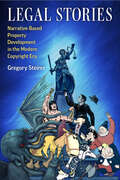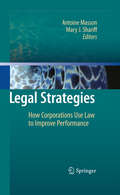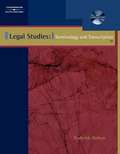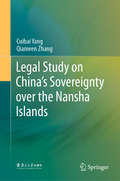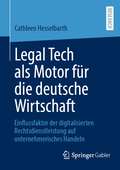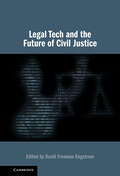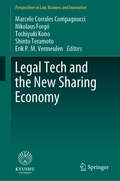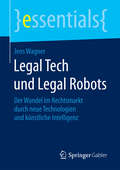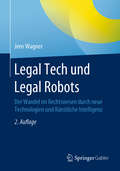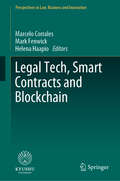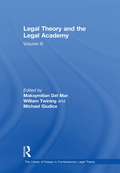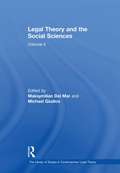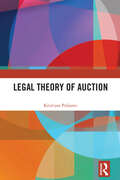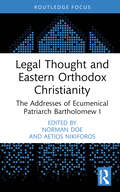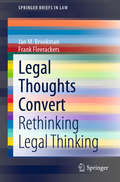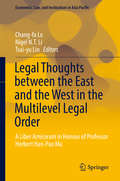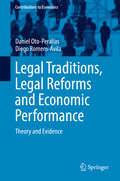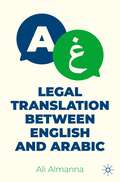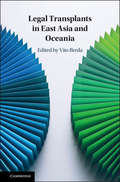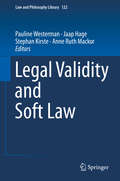- Table View
- List View
Legal Stories: Narrative-Based Property Development in the Modern Copyright Era
by Gregory SteirerTracing the emergence of what the media industries today call transmedia, story worlds, and narrative franchises, Legal Stories provides a dual history of copyright law and narrative-based media development between the Copyright Act of 1909 and the Copyright Act of 1976. Drawing on archival material, including legal case files, and employing the principles of actor-network theory, Gregory Steirer demonstrates how the meaning and form of narrative-based property in the twentieth century was integral to the letter and practice of intellectual property law during this time. Steirer’s expansive view of intellectual property law encompasses not only statutes and judicial opinions, but also the everyday practices and productions of authors, editors, fans, and other legal laypersons. The result is a history of the law as improvisatory and accident-prone, taking place as often outside the courtroom as inside, and shaped as much by laypersons as lawyers. Through the examination of influential legal disputes involving early properties such as Dashiell Hammett’s Sam Spade, H. P. Lovecraft’s Cthulhu Mythos, and Robert E. Howard’s Conan the Barbarian, Steirer provides a ground’s eye view of how copyright law has operated and evolved in practice.
Legal Strategies
by Antoine Masson Mary J. ShariffFar from regarding the law as supreme, corporations approach law as an element of executive thought and action aimed at optimizing competitiveness. The objective of this book is to identify, explore and define corporate legal strategies that seek advantage in the opportunities revealed when the Law is perceived as a resource to be mobilized and aligned with the firm's business and economic agendas.
Legal Strategies in Childhood Obesity Prevention
by Lynn ParkerSince 1980, childhood obesity rates have more than tripled in the United States. Recent data show that almost one-third of children over 2 years of age are already overweight or obese. While the prevalence of childhood obesity appears to have plateaued in recent years, the magnitude of the problem remains unsustainably high and represents an enormous public health concern. All options for addressing the childhood obesity epidemic must therefore be explored. In the United States, legal approaches have successfully reduced other threats to public health, such as the lack of passive restraints in automobiles and the use of tobacco. The question then arises of whether laws, regulations, and litigation can likewise be used to change practices and policies that contribute to obesity. On October 21, 2010, the Institute of Medicine (IOM) held a workshop to bring together stakeholders to discuss the current and future legal strategies aimed at combating childhood obesity. Legal Strategies in Childhood Obesity Prevention summarizes the proceedings of that workshop. The report examines the challenges involved in implementing public health initiatives by using legal strategies to elicit change. It also discusses circumstances in which legal strategies are needed and effective. This workshop was created only to explore the boundaries of potential legal approaches to address childhood obesity, and therefore, does not contain recommendations for the use of such approaches.
Legal Studies: Terminology and Transcription (5th Edition)
by Wanda Roderick-BoltonThis text provides a basic understanding of legal vocabulary for administrative personnel in a legal office. Over 900 terms commonly used in the legal profession are included. Users will learn to define the terms and use them in a legal context. Keyboarding practice from printed copy will reinforce learning the correct spelling and proper use of each term.
Legal Study on China’s Sovereignty over the Nansha Islands
by Cuibai Yang Qianwen ZhangThis book analyzes and discusses the sovereignty of the Nansha Islands, combining legal and historical perspectives, traditional international law theories, and empirical studies based on an extensive body of historical maps from around the globe to do so. Ultimately, the book argues that China has sovereignty over the Nansha Islands and the surrounding waters, either on the basis of historical claims or modern realities.In recent years, the Nansha disputes have attracted considerable attention. Far from being resolved, they have instead become even more heated. The only reasonable way to solve the problem, as argued here, is on the basis of relevant history and legislation. Addressing this highly topical issue, the book also provides an English-speaking audience with access to essential content on the sovereignty, history, and legislation concerning the Nansha Islands.
Legal Symbolism: On Law, Time and European Identity (Applied Legal Philosophy)
by Jiří PřibáňJirà Pribán's book contributes to the field of systems theory of law in the context of European legal and political integration and constitution-making. It puts recent European legislative efforts and policies, especially the EU enlargement process, in the context of legal theory and philosophy. Furthermore, the author shows that the system of positive law has a symbolic meaning, reflecting how it also contributes to the semantics of political identity, democratic power and moral values, as well as the complex relations between law, politics and morality.
Legal Tech als Motor für die deutsche Wirtschaft: Einflussfaktor der digitalisierten Rechtsdienstleistung auf unternehmerisches Handeln
by Cathleen HesselbarthDie Globalisierung und die damit einhergehende Vernetzung der Märkte führt zu einem steigenden Wettbewerbsdruck für Unternehmen. Mit diesem Globalisierungseffekt geht ein Anstieg des juristischen Regelungsbedarfs einher, so dass die Unternehmen vor der Herausforderung stehen, die rechtlichen Blickwinkel sowohl in ihren strategischen als auch in ihren operativen Entscheidungen mit einzubeziehen. Gerade kleine und mittelständische Unternehmen haben strukturell bedingt meist keine eigene Rechtsabteilung oder juristisches Fachpersonal, auf die sie bei der Bearbeitung solcher Themen zurückgreifen können. Somit stehen Sie vor der Wahl, sich stetig rechtlich beraten zu lassen oder tragen das Risiko von Fehlern und möglichen Bußgeldern, was zu einer Verschlechterung der Wirtschaftlichkeit führen kann. Die Unternehmen übertragen damit den steigenden wirtschaftlichen Druck auch auf den juristischen Sektor, der seine Dienstleistungen immer schneller und kostengünstiger anbieten muss. Gerade der juristische Bereich ist durch die Ressource Mensch geprägt, deren Kapazitäten endlich sind. Dr. Cathleen Hesselbarth zeigt, dass Legal-Tech-Anwendungen eine sinnvolle Ergänzung darstellen können, um den Zwiespalt zwischen begrenzten Ressourcen und immer schneller benötigten Informationen zu verringern und schafft gleichzeitig eine fachübergreifende Verbindung zwischen Wirtschaft und Recht.
Legal Tech and the Future of Civil Justice
by David Freeman EngstromNew digital technologies, from AI-fired 'legal tech' tools to virtual proceedings, are transforming the legal system. But much of the debate surrounding legal tech has zoomed out to a nebulous future of 'robo-judges' and 'robo-lawyers.' This volume is an antidote. Zeroing in on the near- to medium-term, it provides a concrete, empirically minded synthesis of the impact of new digital technologies on litigation and access to justice. How far and fast can legal tech advance given regulatory, organizational, and technological constraints? How will new technologies affect lawyers and litigants, and how should procedural rules adapt? How can technology expand – or curtail – access to justice? And how must judicial administration change to promote healthy technological development and open courthouse doors for all? By engaging these essential questions, this volume helps to map the opportunities and the perils of a rapidly digitizing legal system – and provides grounded advice for a sensible path forward.
Legal Tech and the New Sharing Economy (Perspectives in Law, Business and Innovation)
by Toshiyuki Kono Nikolaus Forgó Marcelo Corrales Compagnucci Shinto Teramoto Erik P. M. VermeulenThe exponential growth of disruptive technology is changing our world. The development of cloud computing, big data, the internet of things, artificial intelligence, machine learning, deep learning, and other related autonomous systems, such as self-driving vehicles, have triggered the emergence of new products and services. These significant technological breakthroughs have opened the door to new economic models such as the sharing and platform-based economy. As a result, companies are becoming increasingly data- and algorithm-driven, coming to be more like “decentralized platforms”. New transaction or payment methods such as Bitcoin and Ethereum, based on trust-building systems using Blockchain, smart contracts, and other distributed ledger technology, also constitute an essential part of this new economic model. The sharing economy and digital platforms also include the everyday exchange of goods allowing individuals to commodify their surplus resources. Information and innovation technologies are used in order to then match these resources with existing demand in the market. Online platforms such as Airbnb, Uber, and Amazon reduce information asymmetry, increase the value of unused resources, and create new opportunities for collaboration and innovation. Moreover, the sharing economy is playing a major role in the transition from exclusive ownership of personal assets toward access-based exploitation of resources. The success of online matching platforms depends not only on the reduction of search costs but also on the trustworthiness of platform operators. From a legal perspective, the uncertainties triggered by the emergence of a new digital reality are particularly urgent. How should these tendencies be reflected in legal systems in each jurisdiction? This book collects a series of contributions by leading scholars in the newly emerging fields of sharing economy and Legal Tech. The aim of the book is to enrich legal debates on the social, economic, and political meaning of these cutting-edge technologies. The chapters presented in this edition attempt to answer some of these lingering questions from the perspective of diverse legal backgrounds.
Legal Tech und Legal Robots: Der Wandel im Rechtsmarkt durch neue Technologien und künstliche Intelligenz (essentials)
by Jens WagnerDieses Buch beschreibt und systematisiert die Einsatzbereiche von Legal Tech, einschlie#65533;lich k#65533;nstlicher Intelligenz, er#65533;rtert die Auswirkungen auf Kanzleien und Rechtsabteilungen und zeigt die damit einhergehenden strategischen sowie rechtlichen Implikationen auf. Der Autor geht sowohl auf die theoretischen M#65533;glichkeiten als auch auf aktuelle Anwendungsbeispiele aus der Praxis ein.
Legal Tech und Legal Robots: Der Wandel im Rechtswesen durch neue Technologien und Künstliche Intelligenz (Essentials Ser.)
by Jens WagnerDieses Buch gibt dem Leser sehr schnell einen tieferen Einblick in das Thema Legal Tech. Es beschreibt und systematisiert in kompakter und leicht verständlicher Form die Einsatzbereiche von Legal Tech und geht auf alle relevanten Aspekte rund um das Thema ein. Behandelt werden dabei sowohl der Kontext, in dem sich Legal Tech entwickelt hat, technische Konzepte und Funktionsweisen als auch die Auswirkungen, u.a. auf Kanzleien und Rechtsabteilungen, sowie damit einhergehende strategische und rechtliche Implikationen. Jens Wagner stellt sowohl theoretische Möglichkeiten als auch aktuelle Anwendungsbeispiele aus der Praxis dar.Für die zweite Auflage wurde das in erster Auflage als Springer essential erschienene Werk vollständig überarbeitet und erweitert. Neu sind insbesondere eigene Abschnitte zu Künstlicher Intelligenz, den Auswirkungen von Legal Tech auf Justiz und Verwaltung, innovativen Überlegungen im Bereich der Gesetzgebung sowie zum Thema Kollaboration. Das Buch wendet sich gleichermaßen sowohl an Juristen als auch an Informatiker, die an der Schnittstelle zum Recht arbeiten oder arbeiten wollen.
Legal Tech, Smart Contracts and Blockchain (Perspectives in Law, Business and Innovation)
by Helena Haapio Mark Fenwick Marcelo CorralesThere is a broad consensus amongst law firms and in-house legal departments that next generation “Legal Tech” – particularly in the form of Blockchain-based technologies and Smart Contracts – will have a profound impact on the future operations of all legal service providers. Legal Tech startups are already revolutionizing the legal industry by increasing the speed and efficiency of traditional legal services or replacing them altogether with new technologies. This on-going process of disruption within the legal profession offers significant opportunities for all business. However, it also poses a number of challenges for practitioners, trade associations, technology vendors, and regulators who often struggle to keep up with the technologies, resulting in a widening regulatory “gap.” Many uncertainties remain regarding the scope, direction, and effects of these new technologies and their integration with existing practices and legacy systems. Adding to the challenges is the growing need for easy-to-use contracting solutions, on the one hand, and for protecting the users of such solutions, on the other. To respond to the challenges and to provide better legal communications, systems, and services Legal Tech scholars and practitioners have found allies in the emerging field of Legal Design. This collection brings together leading scholars and practitioners working on these issues from diverse jurisdictions. The aim is to introduce Blockchain and Smart Contract technologies, and to examine their on-going impact on the legal profession, business and regulators.
Legal Theory and the Legal Academy: Volume III (The\library Of Essays In Contemporary Legal Theory Ser.)
by MaksymilianDel MarThe third in a series of three volumes on Contemporary Legal Theory, this volume deals with four topics: 1) the role of legal theory in the legal curriculum; 2) the teaching of legal theory; 3) the relationship of legal theory to legal scholarship; and 4) the relationship of legal theory to comparative law. The focus of the first two topics is on the common law world, where the debates over the aims and proper place of legal theory in the study of law have traversed a good deal of ground since John Austin's 1828 lecture, 'The Uses and the Study of Jurisprudence.' These first two parts offer a selection of the most important papers, including surveys, as well as pedagogical viewpoints and particular course descriptions from analytical, critical, feminist, law-and-literature and global perspectives. The last three decades have seen just as many changes for legal scholarship and comparative law. These changes (such as the rise of empirical legal scholarship) have often attracted the attention of legal theorists. Within comparative law, the last thirty years have witnessed intense methodological reflection within the discipline; the results of these reflections are themselves properly recognised as legal theoretical contributions. The volume collects the key papers, including those by Neil MacCormick, Mark Van Hoecke, Andrew Halpin, William Ewald and Geoffrey Samuel.
Legal Theory and the Social Sciences: Volume II (The\library Of Essays In Contemporary Legal Theory Ser.)
by MaksymilianDel MarEver since H.L.A. Hart's self-description of The Concept of Law as an 'exercise in descriptive sociology', contemporary legal theorists have been debating the relationship between legal theory and sociology, and between legal theory and social science more generally. There have been some who have insisted on a clear divide between legal theory and the social sciences, citing fundamental methodological differences. Others have attempted to bridge gaps, revealing common challenges and similar objects of inquiry. Collecting the work of authors such as Martin Krygier, David Nelken, Brian Tamanaha, Lewis Kornhauser, Gunther Teubner and Nicola Lacey, this volume - the second in a three volume series - provides an overview of the major developments in the last thirty years. The volume is divided into three sections, each discussing an aspect of the relationship of legal theory and the social sciences: 1) methodological disputes and collaboration; 2) common problems, especially as they concern different modes of explanation of social behaviour; and 3) common objects, including, most prominently, the study of language in its social context and normative pluralism.
Legal Theory of Auction
by Kristijan PoljanecThe widespread understanding of auction structure considers auction as consisting of three contracts: contract between the seller and the auctioneer, contract between the auctioneer and the buyer and the sale contract between the seller and the buyer. The book challenges this concept arguing that the traditional tripartite concept of auction is too narrow and does not correspond to the actual structure of auction relations. Demonstrating that an auction structure consists of a plethora of legal relationships, including non-contractual relations, this book explores the legal concept of auction sale and structure of accompanying relations. The book provides a historical overview of auctions and different auction models. Following a brief introduction to the economic theory, auction models are examined against the following legal criteria: price formation, publicity, parties' autonomy, legal form, and applied technology to find a legal concept and nature of auction. The book explores the legal position of key auction figures and auction objects to identify the categories of legal relations that appear at auction. It explores legal nature of the main contract, as well as relations between the consignor and the auctioneer, the auctioneer and the bidders, the bidders, the consignor and the bidders. The book covers relations arising from droit de suite, financial and bidding agreements to provide a comprehensive overview of less known legal relations that commonly arise in auction practice.
Legal Thought and Eastern Orthodox Christianity: The Addresses of Ecumenical Patriarch Bartholomew I (Law and Religion)
by Norman Doe and Aetios NikiforosEcumenical Patriarch Bartholomew I, the spiritual leader of Eastern Orthodox Christians worldwide, has thought profoundly about the role of law as it applies to the church, to civic life in Europe, to human rights, to religious freedom, and to the environment. In this book, leading scholars across the world reflect critically on the significance of his legal thought for human flourishing, for Christian social teaching, and for Christian unity. His legal thought is summed up in five key public addresses that he has delivered around the world in recent years, on: church law as an ecumenical instrument; the role of religion in a changing Europe; Orthodoxy and human rights; religion and freedom; and climate change, ecumenical imperatives. The collection presents critical reflections on the legal thought in these five important, distinct, and topical fields of human life. Its ten chapters, with two chapters devoted to each of his five addresses, are written by leading scholars across the world from different Christian traditions with expertise in the fields studied. They provide an analysis of the legal thought of the Patriarch, explain its significance legally, theologically, and politically, and propose its unifying value for the whole of global Christianity today. The book will be essential reading for academics and researchers working in the areas of law and religion, legal philosophy, comparative canon law, theology, and ecumenical studies.
Legal Thoughts Convert: Rethinking Legal Thinking (SpringerBriefs in Law)
by Jan M. Broekman Frank FleerackersThis book highlights how conversion via communication is one of the most important issues in legal thinking. A major aspect is its link with language – legal texts, judgments, opinions and legal concepts included. Further, conversion is connected to all social positions in law. But a jurist will not solely master specific social behaviors or become the manager of large-scale political fields of law as a legal scientist. A continuously changing integration opens up to his views on reality as it presents itself incessantly. Law and its functionaries are in a never-ending process of change in all domains of culture, which mark the 21st century. Conversions thus concern the riddle of wisdom and automatism, of individual privacy and social fixations, of philosophical considerations and converting flows.
Legal Thoughts between the East and the West in the Multilevel Legal Order
by Chang-Fa Lo Nigel N.T. Li Tsai-Yu LinThis book focuses on the interaction and mutual influences between the East and the West in terms of their legal systems and practices. In this regard, it highlights Professor Herbert H. P. Ma's achievements and his efforts to bring Eastern and Western legal concepts and systems closer together. The book shows that, while there have been convergences between different legal regimes in many fields of law, diverse legal practices and approaches rooted in differing cultural, social, political and philosophical backgrounds do remain, and that these differences are not necessarily negative elements in the contemporary legal order. By examining different levels of the legal order, including domestic, regional and multilateral, it goes on to argue that identifying these diversities and addressing the interactions and mutual influences between different regimes is a worthwhile undertaking, not only in terms of mutual enrichment, but also with regard to intensifying the degree of desirable coordination between different legal systems. All chapters were written by leading experts, practitioners and scholars from different jurisdictions with expertise in various fields of law and different levels of the legal order, and discuss a number of issues with particular focus on either "one-way" or mutual influences between the Eastern and the Western legal systems, practices and philosophies.
Legal Traditions in Asia: History, Concepts and Laws (Ius Gentium: Comparative Perspectives on Law and Justice #80)
by Janos JanyThis book offers a comparative analysis of traditional Asian legal systems. It combines methods from legal history, legal anthropology, legal philosophy, and substantive law, pursuing a comprehensive approach that offers readers a broad perspective on the topic. The geographic regions covered include the Near East, Middle East, Central Asia, India, China, Japan, and Southeast Asia. For each region, the book first provides historical and political context. Next, it discusses major milestones in the region’s legal history and political institutions, as well as its forms of government. Readers are then presented with fundamental principles and terms needed to understand the legal arguments discussed. The book begins with the Ancient Near East and important topics such as Jewish law. The next part considers Islamic law, while also exploring modern issues. The third part focuses on Hindu and Buddhist law, while the fourth part covers China and Japan. The book’s closing section examines tribal societies, e.g. Mongols, Pashtuns and Malays. Topics covered include the interaction of legal systems within a legal circle, inter-systemic interactions, reasons for the failure and success of legal modernization, legal pluralism, and its effects on Asian societies. Family law, law of obligation, criminal law, and procedural law are also explored.
Legal Traditions, Legal Reforms and Economic Performance
by Diego Romero-Ávila Daniel Oto-PeralíasThis book investigates whether legal reforms intended to create a market-friendly regulatory business environment have a positive impact on economic and financial outcomes. After conducting a critical review of the legal origins literature, the authors first analyze the evolution of legal rules and regulations during the last decade (2006-2014). For that purpose, the book uses legal/regulatory indicators from the World Bank's Doing Business Project (2015). The findings indicate that countries have actively reformed their legal systems during this period, particularly French civil law countries. A process of convergence in the evolution of legal rules and regulations is observed: countries starting in 2006 in a lower position have improved more than countries with better initial scores. Also, French civil law countries have reformed their legal systems to a larger extent than common law countries and, consequently, have improved more in the majority of the Doing Business indicators used. Second, the authors estimate fixed-effects panel regressions to analyze the relationship between changes in legal rules and regulations and changes in the real economy. The findings point to a lack of systematic effects of legal rules and regulations on economic and financial outcomes. This result stands in contrast to the widespread belief that reforms aiming to strengthen investor and creditor rights (and other market-friendly policies) systematically lead to better economic and financial outcomes.
Legal Translation between English and Arabic
by Ali AlmannaThis is a coursebook designed for students of translation, which will also benefit professional translators as it covers key issues in contemporary legal translation. The book is divided into two main parts. The first, theoretical part, explores issues such as types of legal texts, readership, communicative purpose, global and local strategies, and modality in addition to analysing the common features of legal discourse in both languages, be they lexical, syntactic, or textual. The second, practical part, discusses issues such as legal rights, contractual obligations, torts, crimes, people and law. It focuses on all types of legal texts, regardless of their classification and examines legislative texts, which have acquired a certain degree of notoriety rarely equalled by any other variety of English.
Legal Transplants in East Asia and Oceania
by Vito BredaThis volume provides a unique overview of methodologies that are conducive to a successful legal transplant in East Asia and Oceania. Each chapter is drafted by a scholar who holds direct professional experience on the legal transplant considered and has a distinctive insight into the pragmatic difficulties related to grafting an alien institution into a legal tradition. The range of transplants includes the implementation of contractual obligations, the regulation of commercial investments and the protection of the environment. The majority of recent legal reforms in these geographical areas have aimed at improving national economic performance and fostering trade and have been directly inspired by European and North American institutional experiences. There is also, however, a tendency to couple economic reforms, aimed at attracting foreign investment, with constitutional reforms that improve the protection of individual rights, the environment and the rule of law.
Legal Validity and Soft Law (Law and Philosophy Library #122)
by Jaap Hage Pauline Westerman Stephan Kirste Anne Ruth MackorThis book features essays that investigate the nature of legal validity from the point of view of different traditions and disciplines. Validity is a fascinating and elusive characteristic of law that in itself deserves to be explored, but further investigation is made more acute and necessary by the production, nowadays, of soft law products of regulation, such as declarations, self-regulatory codes, and standardization norms. These types of rules may not exhibit the characteristics of formal law, and may lack full formal validity but yet may have a very real impact on people's lives. The essays focus on the structural properties of hard and soft legal phenomena and the basis of their validity. Some propose to redefine validity: to allow for multiple concepts instead of one and/or to allow for a gradual concept of validity. Others seek to analyze the new situation by linking it to familiar historical debates and well-established theories of law. In addition, coverage looks at the functions of validity itself. The discussion considers both international law as well as domestic law arrangements. What does it mean to say that something is valid? Should we discard validity as the determining aspect of law? If so, what does this mean for our concept of law? Should we differentiate between kinds of validity? Or, can we say that rules can be "more" or "less" valid? After reading this book, practitioners, scholars and students will have a nuanced understanding of these questions and more.Chapter 6 is available open access under a Creative Commons Attribution 4.0 International License via link.springer.com.
Legal Violence and the Limits of the Law: Cruel and Unusual
by Amy Swiffen Joshua NicholsWhat is the meaning of punishment today? Where is the limit that separates it from the cruel and unusual? In legal discourse, the distinction between punishment and vengeance—punishment being the measured use of legally sanctioned violence and vengeance being a use of violence that has no measure—is expressed by the idea of "cruel and unusual punishment." This phrase was originally contained in the English Bill of Rights (1689). But it (and versions of it) has since found its way into numerous constitutions and declarations, including Article 5 of the Universal Declaration of Human Rights, as well as the Amendment to the US Constitution. Clearly, in order for the use of violence to be legitimate, it must be subject to limitation. The difficulty is that the determination of this limit should be objective, but it is not, and its application in punitive practice is constituted by a host of extra-legal factors and social and political structures. It is this essential contestability of the limit which distinguishes punishment from violence that this book addresses. And, including contributions from a range of internationally renowned scholars, it offers a plurality of original and important responses to the contemporary question of the relationship between punishment and the limits of law.
Legal Words You Should Know: Over 1,000 Essential Terms to Understand Contracts, Wills, and the Legal System
by Corey Sandler Janice KeefeEvery day, people find themselves in legal situations. Mortgages are put in place, attorneys draw up wills, and credit cards are set up all the time. However, how many people actually understood the legal contracts they were signing? There's no excuse for being ignorant of the law when it comes to a dispute with a bank, a mortgage lender, or a lawyer. This book defines 1,000 essential words from the worlds of civil law, estates, lending, and elder affairs, such as abatement, residuary beneficiary, trust deed, variable rate mortgage, right of rescission, and more. Each word will be clearly defined, and includes a pronunciation key and an example of usage. This guide ensures you will know the law in no time!
